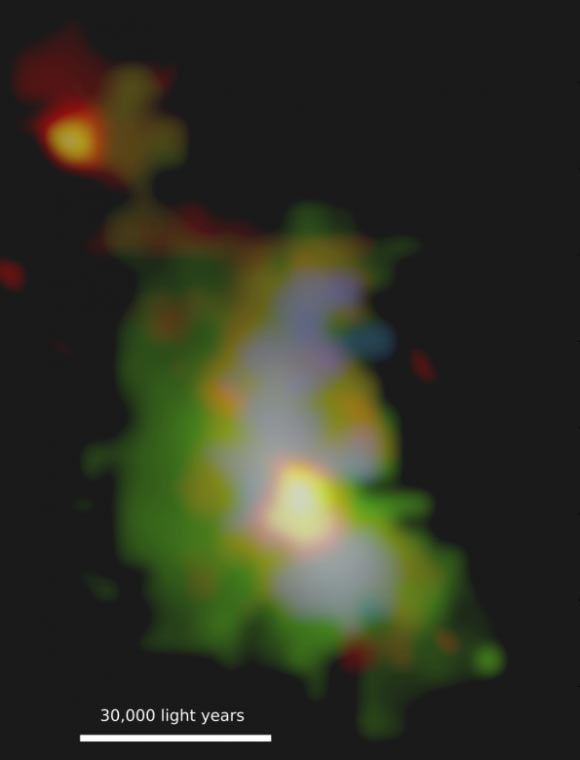New findings from a team of astronomers at the University of California, San Diego, and elsewhere increase understanding of how powerful winds generated by supermassive black holes regulate the growth of galaxies.

This image shows the galaxy 3C 298, located approximately 9.3 billion light-years away. The green colors highlight the energetic gas across the galaxy that is being illuminated by the quasar. The blue color represents powerful winds blowing throughout the galaxy. The red-orange colors represent the cold molecular gas in the system. The supermassive black hole sits at the center of the bright red-orange circular area slightly below the middle of the image. Image credit: Vayner et al.
“Supermassive black holes are captivating. Understanding why and how galaxies are affected by their supermassive black holes is an outstanding puzzle in their formation,” said University of California San Diego Professor Shelley Wright.
Professor Wright and co-authors examined the energetics surrounding the powerful winds generated by the bright, vigorous supermassive black hole (known as a quasar) at the center of a galaxy called 3C 298.
“We study supermassive black holes in the very early Universe when they are actively growing by accreting massive amounts of gaseous material,” Professor Wright said.
“While black holes themselves do not emit light, the gaseous material they chew on is heated to extreme temperatures, making them the most luminous objects in the Universe.”
The study revealed that the winds blow out through the entire galaxy and impact the growth of stars.
“Today, neighboring galaxies show that the galaxy mass is tightly correlated with the supermassive black hole mass,” the astronomers said.
“Our research indicates that 3C 298 does not fall within this normal scaling relationship between nearby galaxies and the supermassive black holes that lurk at their center.”
“But, in the early Universe, the study shows that 3C 298 is 100 times less massive than it should be given its behemoth supermassive black hole mass.”
“This implies that the supermassive black hole mass is established well before the galaxy, and potentially the energetics from the quasar are capable of controlling the growth of the galaxy.”
To conduct the study, they utilized several state-of-the-art astronomical facilities: W.M. Keck Observatory’s OSIRIS integral field spectrograph (IFS) with adaptive optics, the Atacama Large Millimeter/submillimeter Array, the NASA/ESA Hubble Space Telescope, and the Very Large Array.
“The most enjoyable part of researching 3C 298 has been putting together all the data from different wavelengths and techniques,” said Andrey Vayner, also from the University of California, San Diego.
“Each new dataset that we obtained on this galaxy answered one question and helped us put some of the pieces of the puzzle together.”
“However, at the same time, it created new questions about the nature of galaxy and supermassive black hole formation.”
“These findings are the first results from a larger survey of distant quasars and their energetics’ impact on star formation and galaxy growth. We will continue developing results on more distant quasars,” the researchers said.
The findings are described in a paper appearing in the Astrophysical Journal.
_____
Andrey Vayner et al. 2017. Galactic-scale Feedback Observed in the 3C 298 Quasar Host Galaxy. ApJ 851, 126; doi: 10.3847/1538-4357/aa9c42







